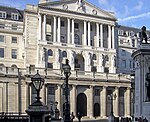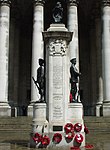Whalebone (eatery)
Demolished buildings and structures in LondonFormer buildings and structures in the City of LondonLevellers

The Whalebone was an eatery on Lothbury in the City of London that was a meeting place for the Leveller movement in the mid 17th century. The Levellers described themselves as "whaleboners" in an early printed declaration, and their leader John Lilburne would read various declarations and lead meetings there. Henry Ireton, Oliver Cromwell's son-in-law, sent spies to the Whalebone to observe the Levellers. It was referred to as one of the Levellers' 'Houses of Parliament', along with the Mouth Inn in Aldersgate. The Windmill Tavern was similarly associated with the Levellers.
Excerpt from the Wikipedia article Whalebone (eatery) (License: CC BY-SA 3.0, Authors, Images).Whalebone (eatery)
Lothbury, City of London
Geographical coordinates (GPS) Address Nearby Places Show on map
Geographical coordinates (GPS)
| Latitude | Longitude |
|---|---|
| N 51.514716666667 ° | E -0.087911111111111 ° |
Address
Lothbury
Lothbury
EC2R 7AP City of London
England, United Kingdom
Open on Google Maps










